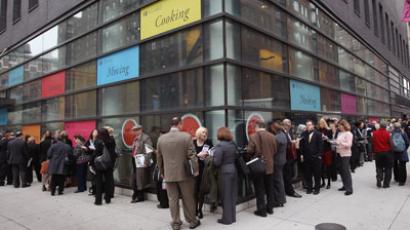Alarming number of US citizens face poverty, 80% will suffer joblessness - report

Four out of five US adults come to grips with joblessness, near-poverty or reliance on welfare for at least some parts of their lives. Over 41 percent of the nation's poor are whites, according to a new report.
In 2011, 46.2 million people in the US were living in poverty and
the nation’s official poverty rate was 15 percent, up from 14.3
percent in 2009, according to the US Census Bureau. That figure
appears to be the highest number seen in the 52 years for which
poverty estimates have been recorded.
Although poverty rates for blacks and Hispanics are
proportionately nearly three times higher, by absolute numbers
the predominant face of the poor is white, the latest report
shows. Economic insecurity among whites is said to be more common
than is shown in the government's poverty data, engulfing over 76
percent of white adults by the time they turn 60, according to a
new economic gauge being published next year by Oxford University
Press.
Pessimism has been steadily growing across the country, with 63
percent of whites describing the US economy as ‘poor’ in the most
recent AP-GfK poll. It’s believed that he growing gap between
rich and poor and the loss of good-paying manufacturing jobs are
to blame.
"If you do try to go apply for a job, they're not hiring people,
and they're not paying that much to even go to work," a
Buchanan County resident, 52-year-old Irene Salyers said, adding
that where she lives children have "nothing better to do than
to get on drugs."
Almost one out of sixteen people in the USA are living in deep
poverty. The risks of poverty have been growing in recent
decades, especially among people aged 35-55. For instance, people
aged 35-45 had a 17 percent risk of encountering poverty during
1969-1989; the risk increased to 23 percent during the period
1989-2009.
Over 19 million whites fall below the poverty line of $23,021 for
a family of four, accounting for over 41 percent of the US
destitute, nearly double the number of poor blacks, according to
the survey data revealed by AP. By 2030 up to 85 percent of all
working-age adults in the US will experience economic insecurity.

Although by race, non-whites still have a higher risk of being
economically insecure, compared with the official poverty rate,
some of the biggest increases under the newer measure are among
whites, with over 76 percent experiencing bouts of joblessness,
life on welfare or near-poverty.
The share of children living in high-poverty neighborhoods —
those with poverty rates of 30 percent or more — has increased to
one in 10, putting them at higher risk of teenage pregnancy or
dropping out of school. Non-Hispanic whites accounted for 17
percent of the child population in such neighborhoods, compared
with 13 percent in 2000, even though the overall proportion of
white children in the US has been declining.
The share of black children in high-poverty neighborhoods dropped
from 43 percent to 37 percent, while the share of Latino children
went from 38 percent to 39 percent.
According to the nation's leading domestic hunger-relief charity
Feeding America, over 16 million children under the age of 18 (21
percent) were in poverty in 2011.
"It's time that America comes to understand that many of the
nation's biggest disparities, from education and life expectancy
to poverty, are increasingly due to economic class position,"
a Harvard professor who specializes in race and poverty William
Julius Wilson told AP.
"There is the real possibility that white alienation will
increase if steps are not taken to highlight and address
inequality on a broad front," he warned.














